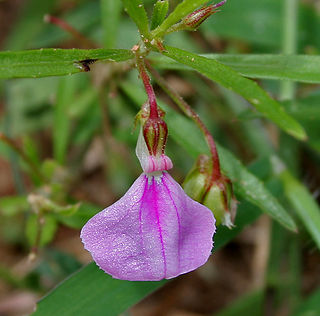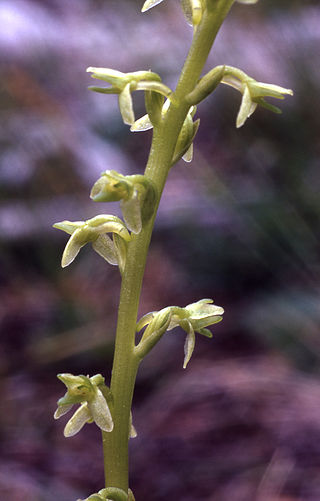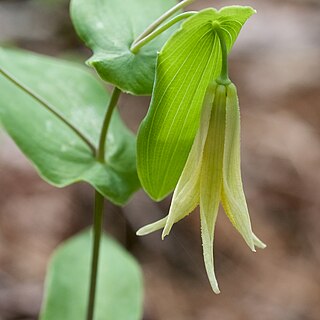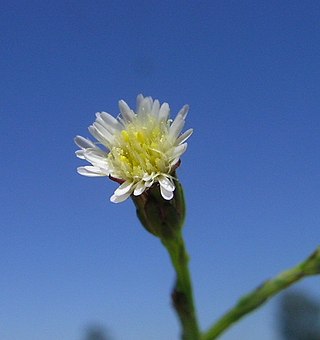
Craspedia is a genus of flowering plants in the family Asteraceae commonly known as billy buttons and woollyheads. They are native to Australia and New Zealand where they grow in a variety of habitats from sea level to the Alps. The genus is found in every state of Australia but not in the Northern Territory. In New Zealand, Craspedia is found from East Cape on the North Island south to Stewart Island. It also occurs on Campbell Island and the Chatham Islands.

Stylophorum diphyllum, commonly called the celandine poppy or wood poppy, is an herbaceous plant in the poppy family (Papaveraceae). It is native to North America, where it is found in the eastern United States and Ontario. Its typical natural habitat is moist forests over calcareous rock, particularly in ravines.

Hydrophyllum virginianum, commonly called Virginia waterleaf or eastern waterleaf, is a species of plant in the borage family (Boraginaceae). It is an herbaceous perennial plant native to Eastern North America where it is primarily found in the Midwest, Northeast, and Appalachian regions.

Viola sororia, known commonly as the common blue violet, is a short-stemmed herbaceous perennial plant that is native to eastern North America. It is known by a number of common names, including common meadow violet, purple violet, woolly blue violet, hooded violet, and wood violet.

Eurybia macrophylla, commonly known as the bigleaf aster, large-leaved aster, largeleaf aster or bigleaf wood aster, is an herbaceous perennial in the family Asteraceae that was formerly treated in the genus Aster. It is native to eastern North America, with a range extending from eastern and central Canada through the northeastern deciduous and mixed forests of New England and the Great Lakes region and south along the Appalachians as far as the northeastern corner of Georgia, and west as far as Minnesota, Missouri and Arkansas. The flowers appear in the late summer to early fall and show ray florets that are usually either a deep lavender or violet, but sometimes white, and disc florets that are cream-coloured or light yellow, becoming purple as they mature. It is one of the parent species of the hybrid Eurybia × herveyi.

Viola pedata, the birdsfoot violet, bird's-foot violet, or mountain pansy, is a violet native to sandy areas in central and eastern North America.

Solidago flexicaulis, the broadleaved goldenrod, or zigzag goldenrod, is a North American species of herbaceous perennial plants in the family Asteraceae. It is native to the eastern and central parts of the United States and Canada, from Nova Scotia west to Ontario and the Dakotas, and south as far as Alabama and Louisiana. It grows in a variety of habitats including mesic upland forests, well drained floodplain forests, seepage swamp hummocks, and rocky woodlands.

Hybanthus (green-violet) is a genus of flowering plants in the family Violaceae. This genus name is Greek for "humpback flower", referring to the drooping pedicels of plants that are part of this genus. The genus is grossly polyphyletic and may contain up to nine different genera, of which Pombalia Vand., Cubelium Raf. and Pigea DC. have been previously recognised.

Cirsium discolor, the field thistle, is a North American species of plants in the tribe Cardueae within the family Asteraceae. It is native to thirty-three states in the United States as well four Canadian provinces. It occurs across much of eastern and central Canada as well as eastern and central United States. It has been found from New Brunswick west to Saskatchewan and south as far as Texas and Georgia.

Platanthera unalascensis is a species of orchid known by the common names slender-spire orchid, Alaska piperia and Alaska rein orchid. It is native to much of western North America from Alaska to the southwestern United States, as well as eastern sections of Canada and the Great Lakes. It can be found in forest, woodland, and scrub habitat, often in dry areas. This orchid grows erect to about 70 centimeters in maximum height. The basal leaves are up to 15 centimeters long by 4 wide. Leaves higher on the stem are much reduced. The upper part of the stem is a slender, spikelike inflorescence of widely spaced translucent green flowers. The flowers are fragrant in the evenings, with a musky, soapy, or honeylike scent. The plant is variable in size, stem thickness, density of inflorescence, petal shape, and scent. Plants of the coast ranges and the Pacific Northwest are stouter and have broader sepals and petals than do interior and montane forms.

Vaccinium pallidum is a species of flowering plant in the heath family known by the common names hillside blueberry, Blue Ridge blueberry, late lowbush blueberry, and early lowbush blueberry. It is native to central Canada (Ontario) and the central and eastern United States plus the Ozarks of Missouri, Arkansas, southeastern Kansas and eastern Oklahoma.

Delphinium exaltatum, known by the common name tall larkspur, is a species of flowering plant in the genus Delphinium, part of the buttercup family. Other Delphinium species are also commonly known as tall larkspur, such as Delphinium barbeyi. D. exaltatum is native to the central and eastern United States, where it can be found in Kentucky, Maine, Ohio, Pennsylvania, Maryland, West Virginia, Virginia, North Carolina, Alabama, Tennessee, and Missouri.

Uvularia perfoliata, the perfoliate bellwort, is a perennial forb native to the eastern United States and Canada, which produces pale yellow flowers in spring.

Medeola virginiana, known as Indian cucumber, cucumber root, or Indian cucumber-root, is an eastern North American plant species in the lily family, Liliaceae. It is the only currently recognized plant species in the genus Medeola. It grows in the understory of forests. The plant bears edible rhizomes that have a mild cucumber-like flavor.

Liparis liliifolia, known as the brown widelip orchid, lily-leaved twayblade, large twayblade, and mauve sleekwort, is a species of orchid native to eastern Canada and the eastern United States. It can be found in a variety of habitats, such as forests, shrublands, thickets, woodlands, and mountains. The orchid is considered globally secure, but it is considered rare or endangered in many northeastern states.

Symphyotrichum oolentangiense, commonly known as skyblue aster and azure aster, is a species of flowering plant in the family Asteraceae native to eastern North America.

Symphyotrichum subulatum, commonly known as eastern annual saltmarsh aster or, in Britain and Ireland where it is naturalized, annual saltmarsh aster, is an annual plant in the family Asteraceae native to the eastern United States and the Gulf Coast to Texas. The species grows primarily in coastal salt marshes, although in the Ozarks it occurs as a non-marine weedy variety.

Viola sagittata, commonly called the arrowleaf violet, is a species of flowering plant in the violet family (Violaceae). It is native to the eastern North America in Canada and the United States, where it is widespread. It is found in a variety of natural habitats, but is most common in dry, open communities such as prairies, glades, or woodlands, often in sandy or rocky soil.

Carex albicans, commonly called whitetinge sedge, is a species of flowering plant in the sedge family (Cyperaceae). It is native to the eastern North America, where it is found in Canada and the United States. Its typical natural habitat is dry forests and woodlands.

Symphyotrichum urophyllum is a species of flowering plant in the family Asteraceae native to eastern North America, commonly known as arrowleaf aster.






















